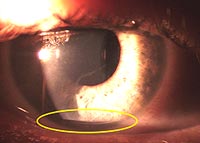Today’s IOLs can correct nearly all hyperopia, myopia, presbyopia
 Uday Devgan |  Tina Geis | ||
With modern techniques of surgery and ocular biometry, cataract surgery is now a type of refractive surgery. A lot has progressed in the past decade: the incisions have become smaller and more astigmatically neutral; the procedure is faster and safer, with most cases done in less than 10 minutes; the biometry is light-based – instead of ultrasound based – and more accurate; and some IOLs are even available in 0.25-D steps. The IOL has the ability to correct all of the patient’s hyperopia or myopia, and the accommodating and multifocal IOLs can even address the patient’s presbyopia.
For astigmatism, toric single-focus IOLs aim to neutralize the corneal cylinder by introducing lenticular astigmatism. However, the current generation of toric IOLs do not have the ability to address presbyopia. For patients with less than 2 D of corneal astigmatism as measured on keratometry, limbal relaxing incisions (LRIs) can be made in the peripheral cornea on the steep axis.
Measuring preop astigmatism
 |
||
 This 59-year-old woman with a history of cataracts and 2 D of with-the-rule astigmatism underwent cataract surgery with implantation of an accommodating IOL (top photo). Paired limbal relaxing incisions at the 90-degree meridian were made with a diamond blade, resulting in a reduction to 0.25 D of residual astigmatism after surgery. Note the appearance of the limbal relaxing incisions postoperatively (bottom photo). Within the yellow oval, notice the white circumferential arc just inside of the limbal vessels. Images: Devgan U and Geis T |
||
Because we will be removing the human crystalline lens during cataract surgery, lenticular astigmatism will be eliminated. This means that the corneal astigmatism is the source for any refractive cylinder seen after surgery. The most important preoperative measurement to determine the need for surgical astigmatism management is keratometry. The subjective manifest refraction is not as important because it represents both lenticular and corneal astigmatism.
Before surgery, we perform corneal topography to determine the extent, symmetry and meridian of corneal astigmatism. The keratometry measurements are useful to confirm the axis and extent of the corneal cylinder. For the comanaging doctor, providing accurate preoperative keratometry for cataract patients is often more important than the refraction.
Limbal relaxing incisions
We can decrease the corneal astigmatism by making one or a pair of incisions along the limbus in the peripheral cornea. These incisions are created with a fine diamond blade and are arc-shaped; the longer incisions (up to 3 clock hours) correct more astigmatism, while the shorter incisions (1 clock hour) correct less astigmatism. In addition, the surgeon will vary the depth of these incisions, with deeper incisions causing more corneal flattening in that meridian. Incisions that are closer to the corneal periphery and limbus have less flattening effect than those more centrally located.
While similarities exist between the LRI incisions and the astigmatic keratotomy incisions from the radial keratotomy days, the LRIs are more peripheral so they heal more predictably, have better long-term stability and are less likely to induce irregular changes.
LRIs tend to heal quickly and stabilize within a few weeks. The incisions may be somewhat open during the first week after surgery, but they should close quickly, with the epithelium filling in any defects. After 1 week, the corneal LRIs may be gaping open in fewer than 5% of patients; a temporary bandage contact lens can help them close. In the rare circumstance that these LRIs do not close within a few weeks, we suggest referring the patient to the surgeon, as suture closure may be required.
Watch for postop dry eye
Because corneal nerves can be temporarily cut during the LRI procedure, as with LASIK patients, these patients may be more susceptible to dry eye issues for a few months after surgery. For routine postoperative visits, be sure to look for signs of tear film deficiency and treat appropriately.
When healed properly, the LRIs look like thin white lines around the circumference of the edge of the cornea. Postoperative refractive stability should be achieved at the 2-week mark, at which time we can measure for any residual cylinder.
Residual cylinder
Many patients tolerate a small amount of with-the-rule cylinder and find that it increases their depth of field. Astigmatism of a diopter or more, however, tends to degrade image quality and is typically addressed. Checking postoperative keratometry and corneal topography can demonstrate the effect of the LRIs in reducing astigmatism.
For patients with residual cylinder that must be treated, we prefer to perform excimer laser-based ablations (either LASIK or PRK) 3 months or longer after the initial cataract surgery.
For more information:
- Uday Devgan, MD, FACS is a partner at the Maloney Vision Institute in Los Angeles and he is chief of ophthalmology at Olive View-UCLA Medical Center and an associate clinical professor at the UCLA School of Medicine.
- Tina Geis, OD, specializes in the preoperative evaluation and postoperative care of patients at Maloney Vision Institute.
- Both doctors can be reached at Maloney Vision Institute, 19021 Wilshire Blvd. #900, Los Angeles, CA 90024; (310) 208-3937; fax: (310) 208-0169; www.maloneyvision.com; e-mail: drdevgan@maloneyvision.com and drgeis@maloneyvision.com.
